Abstract
Bundelkhand region is highly susceptible to meteorological and hydrological droughts, because of the reduced rainfall due to climate change and higher water demand for agriculture. The temporal and spatial drought characteristics of the Bundelkhand region were estimated by the standardized precipitation index (SPI) for the period 1961–2016. Non-parametric statistical tests including, the Mann-Kendall (MK) and Spearman’s rho (SR) have been used in precipitation and SPI series to detect monotonic trends. Statistical tests showed a significant decreasing trend for annual rainfall data with ZMK statistic ranges from −3.93 to −5.54 and ZSR statistics from −4.42 to −7.17 at 5% significant level. Additionally, the magnitude of trend was estimated by using Sen’s slope estimator and the Mi values range from −9.72 to −17.33 which define the extreme condition of drought. Linear regression analysis for monsoon months and annual precipitation also shows the negative slope value, indicating a considerably decreasing trend. Variable-sized cluster analysis (VSCA) provides a visible picture of the irregular rainfall pattern and has been employed for 3-D characterization of rainfall trends and their change point. Trend analysis of SPI on different timescale revealed a negative trend and that negative trend increases with increasing timescale. The highest ranges of drought index indicate the severe to extreme drought category for the study area. The significant drought event with high intensity occurred in 1966, 1987–1990, 1993–1995, 2002, 2007, 2011, and 2015.





Similar content being viewed by others
Data availability
All the data used during the study were provided by a third party and direct request for these materials may be made to the provider as indicated in the acknowledgement.
References
AghaKouchak A, Feldman D, Hoerling M, Huxman T, Lund J (2015) Recognize anthropogenic drought. Nature 524(7566):409–411
Alam NM, Mishra PK, Jana C, Adhikary PP (2014) Stochastic model for drought forecasting for Bundelkhand region in central India. Indian J. Agric. Sciences 82(2):79–84
Amrit K, Soni AR, Sunayana et al (2020) Assessment of frequency and severity of droughts in Maharashtra state of India. Arab J Geosci 13:1294. https://doi.org/10.1007/s12517-020-06400-9
Asadi Zarch MA, Malekinezhad H, Mobin MH et al (2011) Drought monitoring by Reconnaissance Drought Index (RDI) in Iran. Water Resour Manage 25:3485. https://doi.org/10.1007/s11269-011-9867-1
Barua S, Muttil N, Ng AWM, Perera BJC (2013) Rainfall trend and its implications for water resource management within the Yarra River catchment. Australia. Hydrol. Proc. 27(12):1727–1738
Brown JF, Wardlow BD, Tadesse T, Hayes MJ, Reed BC (2008) The Vegetation Drought Response Index (VegDRI): a new integrated approach for monitoring drought stress in vegetation. GISci. Remote Sens. 45(1):16–46
Bayazit M (2015) Nonstationarity of hydrological records and recent trends in trend analysis: a state-of-the-art review. Environ. Processes 2(3):527–542
Da Silva RM, Santos CA, Moreira M, Corte-Real J, Silva VC, Medeiros IC (2015) Rainfall and river flow trends using Mann-Kendall and Sen’s slope estimator statistical tests in the Cobres River basin. Natural Hazards 77(2):1205–1221
Dahmen ER, Hallm MJ (1990) Screening of hydrological data: tests for stationarity and relative consistency, Publication: 49, ILRI, Wageningen, The Netherlands
Dash SK, Jenamani RK, Kalsi SR, Panda SK (2007) Some evidence of climate change in twentieth-century India. Clim Chang 85(3–4):299–321
David V, Davidova T (2017) Relating Hydrological and Meteorological Drought Indices in order to identify causes of low flows in the catchment of Blanice River. Environ. Process 4:149–161
Diodato N, Ceccarelli M, Bellocchi G (2008) Decadal and century-long changes in the reconstruction of erosive rainfall anomalies in a Mediterranean fluvial basin. Earth Surf Process Landf 33(13):2078–2093
Ghosh KG (2018) Analysis of rainfall trends and its spatial patterns during the last century over the Gangetic West Bengal, Eastern India. J Geovisualization Spatial Anal 2:15
Ghosh KG (2019) Spatial and temporal appraisal of drought jeopardy over Gangetic West Bengal, eastern India. Geoenvironmental Disasters 6:1
Gocic M, Trajkovic S (2013) Analysis of precipitation and drought data in Serbia over the period 1980–2010. J. Hydrol. 494:32–42
Gupta AK, Nair SS, Ghosh O, Singh A, Dey S (2014) bundelkhand drought: retrospective analysis and way ahead. National Institute of Disaster Management, New Delhi, p. 148
Gupta SK, Gupta N, Singh VP (2020) Variable-sized cluster analysis for 3-D pattern characterization of trend in precipitation and change point detection. J. Hydrol. Eng. https://doi.org/10.1061/(ASCE)HE.1943-5584.0002010
Hao Z, AghaKouchak A (2013) Multivariate Standardized Drought Index: a multi-index parametric approach for drought analysis. Adv. Water Resour. 57:12–18
IPCC (2014) Intergovernmental panel on climate change : impacts, adaptation, and vulnerability. http://www. ipcc.ch/repor t/ar5/wg2. Accessed 15 November 2019
Jain MK, Jain V, Pandey RP (2012) Impact of climate change on extreme drought events in Ken River basin, India. American Society of Agricultural and Biological Engineers (ASABE), St. Joseph, MI
Jain SK, Kumar V (2012) Trend analysis of rainfall and temperature data for India. Current Science. 102(1):37
Jamshidi S, Zand-Parsa S, Naghdyzadegan Jahromi M, Niyogi D (2019a) Application of a simple Landsat-MODIS fusion model to estimate evapotranspiration over a heterogeneous sparse vegetation region. Remote Sensing 11(7):741
Jamshidi S, Zand-parsa S, Pakparvar M, Niyogi D (2019b) Evaluation of evapotranspiration over a semiarid region using multiresolution data sources. Journal of Hydrometeorology 20(5):947–964
Jamshidi S, Zand-Parsa S, Kamgar-Haghighi AA, Shahsavar AR, Niyogi D (2020) Evapotranspiration, crop coefficients, and physiological responses of citrus trees in semi-arid climatic conditions. Agricultural Water Management 227:105838
Jemai S, Kallel A, Agoubi B et al (2022) Spatial and temporal rainfall variability and its controlling factors under an arid climate condition: case of Gabes Catchment, Southern Tunisia. Environ Dev Sustain 24:5496–5513. https://doi.org/10.1007/s10668-021-01668-7
Jemai S, Kallel A, Abida H (2018) Drought distribution using the standardized precipitation index: case of Gabes Basin. South Tunisia. Arab J Geosci 11:737. https://doi.org/10.1007/s12517-018-4053-x
Kedia, S. (2010) Forming the basis for integration of local climate governance into development plans for resilient livelihood transformations in Bundelkhand region: two opposing perspectives. Working Paper. Development Studies Association (DSA) Annual Conference 2009, Contemporary Crises and New Opportunities.
Kendall MG (1975) Rank correlation methods, 4th edn and 5th edn. Charles Griffin: London. ISBN-13: 978-0195208375
Kilimani N, Van Heerden J, Bohlmann H, Roos L (2018) Economy-wide impact of drought induced productivity losses. Disaster Prevention and Management: An International Journal
Kumar N, Singh SK, Pandey HK (2018) Drainage morphometric analysis using open access earth observation datasets in a drought-affected part of Bundelkhand, India. Appl Geomat 10:173–189
Mann HB (1945) Non-parametric test against trend. Econometrica 13:245–259
Mapedza E, Amarnath G, Matheswaran K, Nhamo L (2019) Drought and the gendered livelihoods implications for smallholder farmers in the Southern Africa Development Community region. In Current Directions in Water Scarcity Research (Vol. 2, pp. 87-99) Elsevier
Matiu M, Ankerst DP, Menzel A (2017) Interactions between temperature and drought in global and regional crop yield variability during 1961-2014. PloS one 12(5):e0178339
McKee TB, Doesken NJ, Kleist J (1993) The relationship of drought frequency and duration to time steps. 8th Conference on Applied Climatology 17–22 January, Anaheim, CA: 179–184
McKee TB, Doesken NJ, Kleist J (1995) Drought monitoring with multiple timescales. Ninth Conference on Applied Climatology. American Meteorological Society: Dallas, TX: 233–236
Mishra AK, Singh V (2010) A review of drought concepts. J. Hydrol 391:202–216
Moktan S, Pandey RP, Mishra SK, Pokharel RB (2021) Study of drought characteristics in Ken River Basin in Bundelkhand Region in India. Hydrological Extremes. Water Science and Technology Library, vol 97. Springer, Cham. https://doi.org/10.1007/978-3-030-59148-9_6
Mooley DA, Parthasarthy B (1984) Fluctuations of all India summer monsoon rainfall during 1871–1978. Clim Chang 6(3):287–301
Mu Q, Zhao M, Kimball JS, McDowell NG, Running SW (2013) A remotely sensed global terrestrial drought severity index. Bull. Amer. Meteor. Soc. 94(1):83–98
Naresh KM, Murthy CS, Sai SMVR, Roy PS (2012) Spatiotemporal analysis of meteorological drought variability in the Indian region using standardized precipitation index. Meteorol. Appl. 19(2):256–264
Nemati A, Najafabadi SHG, Joodaki G et al (2019) Spatiotemporal drought characterization using gravity recovery and climate experiment (GRACE) in the Central Plateau Catchment of Iran. Environ. Process. https://doi.org/10.1007/s40710-019-00413-7
Nourani V, Mehr AD, Azad N (2018) Trend analysis of hydroclimatological variables in Urmia lake basin using hybrid wavelet Mann–Kendall and Şen tests. Environmental earth sciences 77(5):207
Palmer WC (1965) Meteorological drought (Vol. 30). US Department of Commerce, Weather Bureau
Pandey RP, Pandey A, Galkate RV, Byun H, Mal BC (2010) Integrating hydro-meteorological and physiographic factors for assessment of vulnerability to drought. Water Resour. Manage 24(15):4199–4217
Pandey RP, Mihail D, Jain Vinit K, Jain Manoj K (2016) Assessment of vulnerability to drought towards effective mitigation planning: the case of Ken River Basin in India. J Indian Water Resour Soc IWRS 36(4):36–48
PERSPECTIVES (2010) Drought by design: the man-made calamity in Bundelkhand. Economic and Political Weekly 45(5):33–38 Retrieved April 8, 2021, from http://www.jstor.org/stable/25664064
Sayyad RS, Dakhore KK, Phad SV (2019) Analysis of rainfall trend of Parbhani, Maharshtra using Mann–Kendall test. Econometrica 13:245–259
Sen PK (1968) Estimates of the regression coefficient based on Kendall’s tau. J. Am. Stat. Assoc. 63:1379–1389. https://doi.org/10.2307/2285891
Smakhtin VU, Hughes DA (2004) Review, automated estimation and analyses of Drought Indices in South Asia. Working Paper 83, International Water Management Institute, Colombo, Sri Lanka
Sonali P, Nagesh Kumar D (2013) Review of trend detection methods and their application to detect temperature changes in India. J. Hydrol 476(1):212–227
Tabari H, Abghari H, Hosseinzadeh Talaee P (2012) Temporal trends and spatial characteristics of drought and rainfall in arid and semiarid regions of Iran. Hydrol. Processes 26(22):3351–3361
Thapliyal V, Kulshreshtha SM (1991) Climate changes and trends over India. Mausam 42:333–338
Thomas T, Nayak PC, Ghosh NC (2015) Spatiotemporal analysis of drought characteristics in the Bundelkhand region of central India using the standardized precipitation index. J Hydrol Eng 20 (11): 05015004-1–05015004-12
Tsakiris G, Vangelis H (2004) Towards a drought watch system based on spatial SPI. Water Resources Management 18(1):1–12
Wilhite DA, Glantz MH (1985) Understanding the drought phenomenon: the role of definitions. Water International 10(3):111–120
Wilhite DA, Vanyarkho OV (2000) Drought: pervasive impacts of a creeping phenomenon, chapter 18, Drought: A Global Assesssment, vol.I, Routledge, London, U.K, pp. 245-255
Zhang Z, Dehoff AD, Poddy RD (2010a) New approach to identify trend pattern of streamflow. J. Hydrol. Eng 15(3):244–248
Zhang Z, Dehoff AD, Poddy RD, Balay JW (2010b) Detection of streamflow change in the Susquehanna River Basin. Water Resour Manage 24:1947
Zhang Y, Cai W, Chen Q, Yao Y, Liu K (2015) Analysis of changes in precipitation and drought in Aksu River Basin, Northwest China. Adv. Meteorol 215840
Acknowledgements
The authors express sincere thanks to India Meteorological Department (IMD) and the team of India water portal for providing the precipitation dataset of thirteen districts of Bundelkhand region.
Author information
Authors and Affiliations
Corresponding author
Ethics declarations
Conflict of interest
The authors declare no competing interest.
Additional information
Responsible Editor: Amjad Kallel
Supplementary information
ESM 1
(DOCX 24 kb)
Rights and permissions
About this article
Cite this article
Gupta, N., Gond, S. & Gupta, S.K. Spatiotemporal trend characteristics of rainfall and drought jeopardy over Bundelkhand Region, India. Arab J Geosci 15, 1155 (2022). https://doi.org/10.1007/s12517-022-10389-8
Received:
Accepted:
Published:
DOI: https://doi.org/10.1007/s12517-022-10389-8




